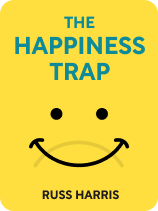

This article is an excerpt from the Shortform book guide to "The Happiness Trap" by Russ Harris. Shortform has the world's best summaries and analyses of books you should be reading.
Like this article? Sign up for a free trial here .
How do you set goals for ACT? How do goals relate to values?
Goals are the actionable components of values in Acceptance and Commitment Therapy (ACT). Knowing your values isn’t sufficient for you to live a fulfilled life—you also have to take effective action, or action aligned with your values. In order to take effective action, you have to translate your values into achievable goals.
In this article, you’ll learn how to translate your values into action via goal-setting and action plans.
Setting Goals
In order to translate these ACT values into goals, we’ll divide them into 11 more specific areas:
- Family
- Marriage and other romantic relationships
- Friendships
- Work and career
- Education and personal development
- Spirituality
- Citizenship and community
- Environment and nature
- Health and wellness
- Leisure
(Shortform note: These categories aren’t iron-clad. If you feel that one of the domains isn’t applicable to you, feel free to eliminate it from the list. Likewise, if you find that you have a significant cluster of values related to a domain that isn’t listed, create a new domain and focus your efforts there.)
Now, take a look at each category and determine the one where you feel least in touch with your values. If you’ve identified more than one domain, determine which of the domains has the most urgent or pressing need for your attention. Harris emphasizes that you pick only one domain—focusing on more than one is likely to be overwhelming and lead to decreased morale (or even abandonment of the process).
1. Now that you’ve selected a domain, write a summary of the values you’re interested in focusing on. For instance, if you selected friendship, you may want to work on the values of being an attentive, kind, and honest friend.
2. Set a goal related to one of these values that you can accomplish today. The easier this goal, the better. Starting small is a good way to ensure that you actually follow through with effective action.
When setting a goal, list what, where, and when. The “what” should be specific—for example, instead of saying, “I’m going to be nice,” say, “I’m going to say one nice thing to my friend.” Specifying the “where” and “when” make the goal more well-defined and achievable, which helps you avoid procrastinating or abandoning the goal.
Additionally, avoid setting prohibitive goals, or goals focused on not doing something. To avoid this, consider what you would like to do instead of doing the thing you don’t want to do. Then, set a goal to do that alternative.
3. Set some goals that you can achieve within the next week. Remember to specify the “what,” the “where,” and the “when.” For instance, if your value in the marriage domain is to be more affectionate with your spouse, you might say, “I’m going to cook a nice, intimate dinner for my spouse at the house this Friday.”
4. Set some goals that you can achieve within the next few weeks or months. Again, specify the “what,” the “where,” and the “when.”
5. Set some goals that you can achieve with years’ worth of effort. This is an opportunity to be ambitious with your goal-setting. It doesn’t matter how realistic you think these goals are in the present moment—if it occurs to you, write it down. For example, if your value in the domain of employment is doing something that truly benefits other people, you might write, “I’ll go back to school in order to change careers from data entry to biomedical engineering.”
| Set Purpose-Driven Goals In First Things First, Stephen R. Covey has a slightly different take on how to set meaningful goals. He suggests three strategies: 1. Set recurring goals. In Covey’s formulation, your goals should follow a “mission,” a “vision,” and “principles”—rather than just the values that Harris has you define. Whereas Harris’s approach involves setting goals that you can accomplish within one week and then moving onto the next step, Covey recommends recurring goals that you consistently accomplish week after week. For instance, instead of setting a goal to cook dinner for your spouse on Friday this week, you would set a goal to cook dinner for your spouse every Friday. This recurring framework aligns with ACT because, as discussed, values involve consistent and repeated behavior. It’s not enough to do something once and then consider the value fulfilled. 2. Set “context” goals. Covey recommends that you set mid- to long-term goals that your weekly goals build toward. In defining context goals, Covey suggests considering the “what” (the goal itself), “why” (the reason for the goal; in ACT, the “why” will also be the underlying value), and “how” (the means by which you will reach the goal). For example, if your weekly goal is eating one serving of vegetables with every meal, your longer-term goal may be to switch to a vegetarian diet (the “what”). You set this goal because you want to eat healthier (the “why,” or value), and you’re going to achieve this by setting mid-term goals to replace two servings of meat per week with legumes. 3. Make a “perhaps” list. A “perhaps” list is filled with goals that you’re not fully committing to but would like to record as possibilities. This is a break from the relatively rigid structure that accompanies goal-setting, and it may help you formulate more ambitious goals in the future. Harris includes this kind of thinking when he recommends setting goals that aren’t necessarily realistic in the long-term goals category. |
Making an Action Plan
Now that you’ve set some goals, it’s time to make an action plan. Harris explains that an action plan breaks down each goal into manageable steps so that you don’t get overwhelmed.
An action plan has three parts. Ask:
- What steps will I need to take to achieve this goal? For example, if you’ve set a goal of going camping, you may need to:
- Research best camping practices
- Find good campsites near you
- Buy a tent or other camping supplies
- Block out the necessary time to go camping
- What materials do I need to achieve this goal? For example, if you don’t already have a tent to go camping, you’ll need to buy (or borrow) one.
- When will I act to achieve my goal? For example, you may decide that, given the time that it will take for you to purchase all of the necessary camping equipment, you’ll go camping a month from now.
Once you’ve answered these questions, you have an action plan.
| An Alternative Approach to Action Plans In The Psychology of Selling, Brian Tracy presents another way to turn your goals into actions. Tracy’s method reorders and combines Harris’s steps, but most significantly, Tracy also adds a step: prioritizing the to-dos in your action plan. Considering Harris states that action plans are meant to make goals more manageable, this step makes the action plan even more manageable. This is Tracy’s approach: Write your goal down. This makes your goal real. If you’ve been following Harris’s exercises, you’ve already done this step. Set a deadline. Tracy argues that by defining the “when” of your goal first, you set your subconscious mind working on the other steps necessary to achieve your goal. This reverses the order Harris suggests, which specifies the “when” in the final step. Make a list of everything you can do to achieve your goal. This is similar to steps 1 and 2 of Harris’s method, combining the manageable steps you’ll need to take to achieve your goal with the added complexity of the materials you’ll need to achieve it. Organize this list. Prioritize the actions to figure out which steps need to be completed first and which can wait until later. Take action. |

———End of Preview———
Like what you just read? Read the rest of the world's best book summary and analysis of Russ Harris's "The Happiness Trap" at Shortform .
Here's what you'll find in our full The Happiness Trap summary :
- Why trying to be happy is making you unhappy
- How to practice ACT, or Acceptance and Commitment Therapy, to become happier
- How to develop “psychological flexibility” toward negative feelings instead of eliminating them






